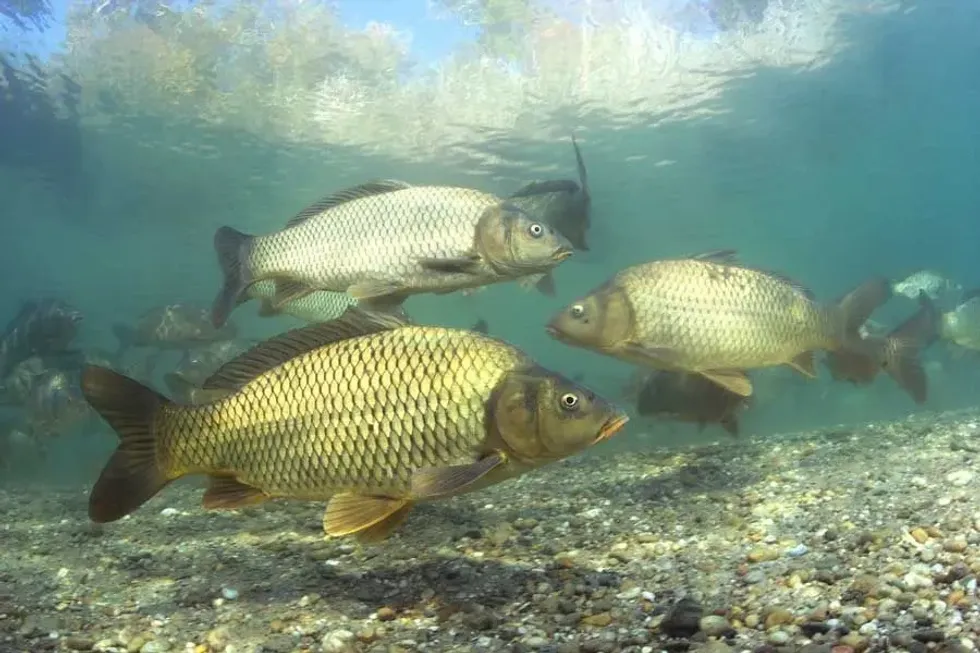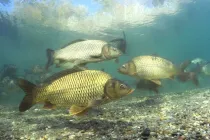The common carp (Cyprinus carpio) is a species of fish that is found in European and Asian countries in freshwater water bodies.
The carp are known to have an amazing hearing ability and a big mouth which helps them consume food more easily. They are known to feed on mollusks, insects, and worms but are occasionally seen eating plants and algae.
The body of this domesticated fish is covered with scales.
It faces a great threat from bigger fishes and humans and is currently a Vulnerable species as per the IUCN. The common carp is a very notorious and enthusiastic domesticated fish but it is known to degrade the water quality and harm other organisms.
The carp is a dangerous organism and some fish, like the Asian carp and silver carp, are capable of injuring humans seriously and even killing them.
The carp is seen breeding throughout the year, and females are known to lay as many as 300,000 eggs at a time. To know more about this fish, why not read this article?
If you like reading these common carp facts, you could also check out some facts on the porcupine fish and the plaice too.
Carps Interesting Facts
What type of animal is a carp?
The carp (Cyprinus carpio) is a fish species that is native to Asia and Europe.
What class of animal does a carp belong to?
The common carp is classified under fishes and falls under the Actinopterygii class.
How many carp are there in the world?
The exact number of individuals is not known but as carp is a Vulnerable species, the number is constantly declining.
Where does a carp live?
Carp are known to live in the ocean and in freshwater water bodies like ponds, lakes, and rivers, that are present in their native continents – Asia and Europe. Asian carp are native to Asia but are also found in the United States, North America.
What is a carp's habitat?
Common carp depend on worms, insects, crustaceans, and mollusks for food and also occasionally eat plants and algae. Common carp are generally found in water bodies like rivers, lakes, and ponds (freshwater water bodies), which are rich in aquatic life.
Who do carp live with?
Common carp are generally seen living in smaller groups, but for the most part, carp prefer to live alone, in solitude.
How long does a carp live?
Carp can live for anything between 15-50 years in the wild and freshwater bodies. The oldest living carp was about 225 years old. Similarly, koi fish are known to live for about 15 years in the wild but can live for about 47 years in captivity. The koi fish (Cyprinus rubrofuscus) are of the genus Cyprinus.
How do they reproduce?
Carps spawn throughout the year, and the breeding is generally carried out in small ponds and cement tanks. Water plants are used to lay eggs, and once they turn into small fry, they are transferred to ponds and rivers. The breeding period is between January to March. The females lay about 300,000 eggs which many males fertilize.
What is their conservation status?
The current conservation status of this fish is Vulnerable and can become endangered soon if nothing is done about them now. The main reason for the decline in the population of carp in countries like the U.S. is hunting and commercial fisheries.
Carps Fun Facts
What do carp look like?
The carp is a medium-sized fish and is found in a variety of colors like white, red, golden, yellow, and black. The carp fishes have large bodies and big fins, and on top of them, they have a pair of eyes and a big mouth which helps them eat their food with ease.
Their body also has bony scales and slippery skin.
How cute are they?
The common carp is a cute and attractive fish with a big mouth. It comes in attractive colors, and the most attractive is the koi as it is very colorful. These fish are very cute during their juvenile phase, but at the same time, these are not the friendliest fish species, so don't fall for their cuteness.
How do they communicate?
The common carp has great hearing skills and is known to communicate often by feeling and touching each other. They also judge their surroundings with the help of their excellent hearing ability.
How big is a carp?
They weigh 8-10 lb (3.6-4.5 kg), and they have a length of 12-24 in (30-60 cm). The common carp is a medium-sized fish species found in ponds, lakes, and rivers. An average common carp is about 10-12 times bigger than its food such as insects.
How fast can a carp swim?
The common carp is known to have a burst speed of 2.27 mph (3.65 kph) and a swimming speed of about 1.14 mph (1.83 kph). These native fish from the European and Asian countries are known to be fast swimmers and extremely quick.
How much does a carp weigh?
The average weight range of this fish is 8-10 lb (3.6-4.5 kg), but some common carps are known to be as big as 30 lb (14.5 kg). The koi are generally lightweight fishes, but the Asian carp and mirror carp are comparatively bigger.
What are the male and female names of the species?
There are no names in particular for the male and female of this species and are referred to as common carps. Carp (Cyprinus carpio) has a variety of species within the carp and has different names like the koi, grass carp, mirror carp, and Asian carp.
What would you call a baby carp?
There is no particular name for a baby carp, and they are universally referred to as young carps.
What do they eat?
The carp are known to feed on a variety of aquatic life and plants as it is an omnivore.
They feed mostly on insects, crustaceans, aquatic worms, mollusks, larvae, small plants, and algae. These species, which are found in Europe and Asian countries, depend on most of the freshwater life for food, which targets and decreases the population of other smaller animals living in the freshwater.
The carp is considered great food in Asian countries, North America and is even consumed in Europe by humans as these fish are native to Asia.
Are they dangerous?
These native fishes from Europe and Asian countries are very dangerous for their behaviors and their survival.
They often disturb the population of smaller aquatic animals either by eating them or by degrading the water quality, which results in killing the sensitive organisms in the freshwater resources.
Apart from being dangerous to aquatic life, this species of carp is very dangerous to humans as a collision between a jumping silver carp, and a human can cause serious damage to humans that may result in death.
However, they are preyed on by birds such as herons, goosanders, cormorants; fishes like largemouth bass and northern pike; as well as mammals like minks and otters.
The carp is known to be a notorious fish species. The carp alters the natural ecosystems and disturbs the complete aquatic life.
While searching for larvae and insects they feed on, the carp is often seen disturbing and uprooting the submerged vegetation. The carp, therefore, stir up phosphorous-containing sediments from the bottom and reduce the clarity of water which in turn gives rise to algal blooms.
Would they make a good pet?
No, carp do not make good pets as these are very notorious and clumsy fishes and can cause a lot of nuisance and disturbance for the fellow fishes and the owners. These fish often uproot sediments and make the water dirty, which makes them less desirable as pets.
Some fishes like goldfish, neon tetra, mollies, cellophane betta, and angelfish do make good pets but keeping a carp as a pet would not be the greatest choice. Although these fish are domesticated yet they cannot be kept as pets.
Did you know...
Carp spawning facts include that the female carp is known to release eggs in the water resources like ponds, lakes, and rivers at a time. The eggs have about seven male carps fertilizing them.
You are disallowed from eating carp in the U.K.
Would you like to catch carp? You can use bread and sweetcorn as your bait for a guaranteed catch. You must also avoid using a very shiny hook because these fish have excellent eyesight, and it could be off-putting for them.
Different types of carps
Silver carp requires slow-flowing or static water and lives in temperate conditions in Asia.
Grass carp are fed banana stems and grasses and their weight ranges from 2-5.2 lb (1-2.3 kg).
Carp spawn throughout the year, with peaks being during Jan-Mar and July-August. When a fry is a week old, it is transferred to a nursery pond.
Carps and humans
Hunting and catching the carp species is not illegal. Anyone can kill it if they wish to, but what is illegal is translocating this fish to another river, pond, or another habitat as it can cause serious disturbances in the aquatic life and population of its prey.
Humans are known to enjoy eating this fish – provided it is cooked properly. This freshwater fish is even domesticated now.
Here at Kidadl, we have carefully created lots of interesting family-friendly animal facts for everyone to discover! Learn more about some other fishes from our john dory facts and pilchard facts pages.
You can even occupy yourself at home by coloring in one of our free printable carp coloring pages.










